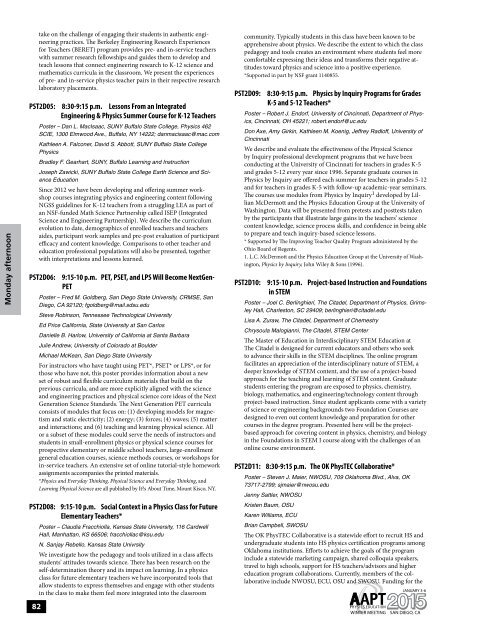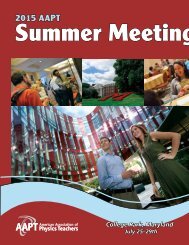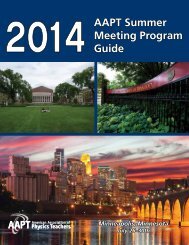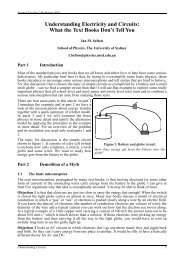final-program-12-23-14-3
final-program-12-23-14-3
final-program-12-23-14-3
You also want an ePaper? Increase the reach of your titles
YUMPU automatically turns print PDFs into web optimized ePapers that Google loves.
Monday afternoon<br />
82<br />
take on the challenge of engaging their students in authentic engineering<br />
practices. The Berkeley Engineering Research Experiences<br />
for Teachers (BERET) <strong>program</strong> provides pre- and in-service teachers<br />
with summer research fellowships and guides them to develop and<br />
teach lessons that connect engineering research to K-<strong>12</strong> science and<br />
mathematics curricula in the classroom. We present the experiences<br />
of pre- and in-service physics teacher pairs in their respective research<br />
laboratory placements.<br />
PST2D05: 8:30-9:15 p.m. Lessons From an Integrated<br />
Engineering & Physics Summer Course for K-<strong>12</strong> Teachers<br />
Poster – Dan L. MacIsaac, SUNY Buffalo State College, Physics 462<br />
SCIE, 1300 Elmwood Ave., Buffalo, NY <strong>14</strong>222; danmacisaac@mac.com<br />
Kathleen A. Falconer, David S. Abbott, SUNY Buffalo State College<br />
Physics<br />
Bradley F. Gearhart, SUNY, Buffalo Learning and Instruction<br />
Joseph Zawicki, SUNY Buffalo State College Earth Science and Science<br />
Education<br />
Since 20<strong>12</strong> we have been developing and offering summer workshop<br />
courses integrating physics and engineering content following<br />
NGSS guidelines for K-<strong>12</strong> teachers from a struggling LEA as part of<br />
an NSF-funded Math Science Partnership called ISEP (Integrated<br />
Science and Engineering Partnership). We describe the curriculum<br />
evolution to date, demographics of enrolled teachers and teachers<br />
aides, participant work samples and pre-post evaluation of participant<br />
efficacy and content knowledge. Comparisons to other teacher and<br />
education professional populations will also be presented, together<br />
with interpretations and lessons learned.<br />
PST2D06:<br />
9:15-10 p.m. PET, PSET, and LPS Will Become NextGen-<br />
PET<br />
Poster – Fred M. Goldberg, San Diego State University, CRMSE, San<br />
Diego, CA 92<strong>12</strong>0; fgoldberg@mail.sdsu.edu<br />
Steve Robinson, Tennessee Technological University<br />
Ed Price California, State University at San Carlos<br />
Danielle B. Harlow, University of California at Santa Barbara<br />
Julie Andrew, University of Colorado at Boulder<br />
Michael McKean, San Diego State University<br />
For instructors who have taught using PET*, PSET* or LPS*, or for<br />
those who have not, this poster provides information about a new<br />
set of robust and flexible curriculum materials that build on the<br />
previous curricula, and are more explicitly aligned with the science<br />
and engineering practices and physical science core ideas of the Next<br />
Generation Science Standards. The Next Generation PET curricula<br />
consists of modules that focus on: (1) developing models for magnetism<br />
and static electricity; (2) energy; (3) forces; (4) waves; (5) matter<br />
and interactions; and (6) teaching and learning physical science. All<br />
or a subset of these modules could serve the needs of instructors and<br />
students in small-enrollment physics or physical science courses for<br />
prospective elementary or middle school teachers, large-enrollment<br />
general education courses, science methods courses, or workshops for<br />
in-service teachers. An extensive set of online tutorial-style homework<br />
assignments accompanies the printed materials.<br />
*Physics and Everyday Thinking, Physical Science and Everyday Thinking, and<br />
Learning Physical Science are all published by Its About Time, Mount Kisco, NY.<br />
PST2D08: 9:15-10 p.m. Social Context in a Physics Class for Future<br />
Elementary Teachers*<br />
Poster – Claudia Fracchiolla, Kansas State University, 116 Cardwell<br />
Hall, Manhattan, KS 66506; fracchiollac@ksu.edu<br />
N. Sanjay Rebello, Kansas State Univrsity<br />
We investigate how the pedagogy and tools utilized in a class affects<br />
students’ attitudes towards science. There has been research on the<br />
self-determination theory and its impact on learning. In a physics<br />
class for future elementary teachers we have incorporated tools that<br />
allow students to express themselves and engage with other students<br />
in the class to make them feel more integrated into the classroom<br />
community. Typically students in this class have been known to be<br />
apprehensive about physics. We describe the extent to which the class<br />
pedagogy and tools creates an environment where students feel more<br />
comfortable expressing their ideas and transforms their negative attitudes<br />
toward physics and science into a positive experience.<br />
*Supported in part by NSF grant 1<strong>14</strong>0855.<br />
PST2D09:<br />
8:30-9:15 p.m. Physics by Inquiry Programs for Grades<br />
K-5 and 5-<strong>12</strong> Teachers*<br />
Poster – Robert J. Endorf, University of Cincinnati, Department of Physics,<br />
Cincinnati, OH 45221; robert.endorf@uc.edu<br />
Don Axe, Amy Girkin, Kathleen M. Koenig, Jeffrey Radloff, University of<br />
Cincinnati<br />
We describe and evaluate the effectiveness of the Physical Science<br />
by Inquiry professional development <strong>program</strong>s that we have been<br />
conducting at the University of Cincinnati for teachers in grades K-5<br />
and grades 5-<strong>12</strong> every year since 1996. Separate graduate courses in<br />
Physics by Inquiry are offered each summer for teachers in grades 5-<strong>12</strong><br />
and for teachers in grades K-5 with follow-up academic-year seminars.<br />
The courses use modules from Physics by Inquiry 1 developed by Lillian<br />
McDermott and the Physics Education Group at the University of<br />
Washington. Data will be presented from pretests and posttests taken<br />
by the participants that illustrate large gains in the teachers’ science<br />
content knowledge, science process skills, and confidence in being able<br />
to prepare and teach inquiry-based science lessons.<br />
* Supported by The Improving Teacher Quality Program administered by the<br />
Ohio Board of Regents.<br />
1. L.C. McDermott and the Physics Education Group at the University of Washington,<br />
Physics by Inquiry, John Wiley & Sons (1996).<br />
PST2D10:<br />
9:15-10 p.m. Project-based Instruction and Foundations<br />
in STEM<br />
Poster – Joel C. Berlinghieri, The Citadel, Department of Physics, Grimsley<br />
Hall, Charleston, SC 29409; berlinghieri@citadel.edu<br />
Lisa A. Zuraw, The Citadel, Department of Chemestry<br />
Chrysoula Malogianni, The Citadel, STEM Center<br />
The Master of Education in Interdisciplinary STEM Education at<br />
The Citadel is designed for current educators and others who seek<br />
to advance their skills in the STEM disciplines. The online <strong>program</strong><br />
facilitates an appreciation of the interdisciplinary nature of STEM, a<br />
deeper knowledge of STEM content, and the use of a project-based<br />
approach for the teaching and learning of STEM content. Graduate<br />
students entering the <strong>program</strong> are exposed to physics, chemistry,<br />
biology, mathematics, and engineering/technology content through<br />
project-based instruction. Since student applicants come with a variety<br />
of science or engineering backgrounds two Foundation Courses are<br />
designed to even out content knowledge and preparation for other<br />
courses in the degree <strong>program</strong>. Presented here will be the projectbased<br />
approach for covering content in physics, chemistry, and biology<br />
in the Foundations in STEM I course along with the challenges of an<br />
online course environment.<br />
PST2D11: 8:30-9:15 p.m. The OK PhysTEC Collaborative*<br />
Poster – Steven J. Maier, NWOSU, 709 Oklahoma Blvd., Alva, OK<br />
73717-2799; sjmaier@nwosu.edu<br />
Jenny Sattler, NWOSU<br />
Kristen Baum, OSU<br />
Karen Williams, ECU<br />
Brian Campbell, SWOSU<br />
The OK PhysTEC Collaborative is a statewide effort to recruit HS and<br />
undergraduate students into HS physics certification <strong>program</strong>s among<br />
Oklahoma institutions. Efforts to achieve the goals of the <strong>program</strong><br />
include a statewide marketing campaign, shared colloquia speakers,<br />
travel to high schools, support for HS teachers/advisors and higher<br />
education <strong>program</strong> collaborations. Currently, members of the collaborative<br />
include NWOSU, ECU, OSU and SWOSU. Funding for the<br />
WINTER MEETING<br />
JANUARY 3-6<br />
2015<br />
SAN DIEGO, CA






